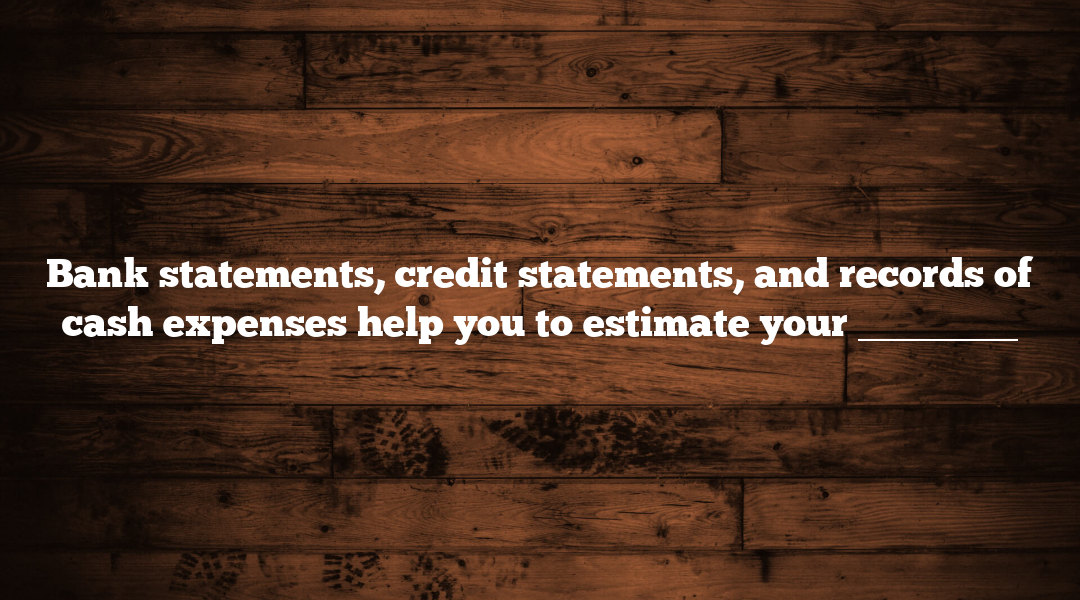Bank statements, credit statements, and records of cash expenses help you to estimate your ________
In the world of personal finance, your financial statements are like the treasure maps to your financial future. They hold the clues and insights that can help you navigate the twists and turns of your financial journey. Whether it’s your bank statements, credit card statements, or investment statements, these financial documents are more than just numbers; they are powerful tools for predicting and shaping your financial future. In this comprehensive guide, we’ll delve into the often-overlooked gems hidden within your statements and explore how they can empower you to make informed decisions and build a brighter financial future.
Unveiling the Hidden Insights in Your Statements
Financial Statements as Mirrors
Think of your financial statements as mirrors reflecting your financial reality. They provide a snapshot of your financial activities, behaviors, and choices. Understanding how to read and interpret these statements is like having the ability to gaze into a crystal ball to predict what lies ahead in your financial future.
Key Takeaway: Your financial statements offer a clear reflection of your financial past and present, enabling you to make predictions about your financial future.
Types of Statements
There are various types of financial statements, each serving a unique purpose:
- Bank Statements: These detail your transactions, including deposits, withdrawals, and balances, in your checking and savings accounts.
- Credit Card Statements: These outline your credit card transactions, including purchases, payments, and outstanding balances.
- Investment Statements: These provide a summary of your investment portfolio’s performance, including gains, losses, and current holdings.
- Income Statements: For businesses, income statements show revenues, expenses, and profitability over a specific period.
- Balance Sheets: Also for businesses, balance sheets provide a snapshot of assets, liabilities, and equity at a specific point in time.
For personal finance, bank statements and credit card statements are the most commonly used, offering valuable insights into your cash flow and spending habits.
Why Predicting Your Financial Future Matters
Proactive Financial Planning
Predicting your financial future is not about fortune-telling; it’s about proactive financial planning. It enables you to make informed decisions, set realistic goals, and take the necessary steps to achieve those goals.
Key Takeaway: Proactive financial planning based on predictions empowers you to shape your financial future intentionally.
Risk Mitigation
Predicting potential financial challenges or setbacks allows you to take preventive measures. Whether it’s building an emergency fund or diversifying your investments, foresight helps you mitigate risks and safeguard your financial well-being.
Key Takeaway: Predicting financial risks allows you to implement strategies to protect your financial future.
Unlocking Hidden Insights in Your Statements
Now, let’s explore practical ways to unlock the hidden insights in your financial statements and use them to predict your financial future.
Step 1: Gather Your Statements
Start by collecting your most recent financial statements. Ensure you have bank statements, credit card statements, and any other relevant financial documents readily available.
Pro Tip: Create a digital folder to organize and store your financial statements for easy access.
Step 2: Analyze Your Cash Flow
Review your bank statements to analyze your cash flow. Track your income sources and the frequency of deposits. Take note of your regular expenses, both fixed (e.g., rent or mortgage) and variable (e.g., groceries, dining out).
Key Takeaway: Understanding your cash flow patterns helps you predict your ability to meet your financial obligations and save for the future.
Step 3: Identify Spending Habits
Use your credit card statements to identify your spending habits. Categorize your expenses into specific categories such as groceries, entertainment, utilities, and debt repayments. Calculate your average monthly spending in each category.
Pro Tip: Many credit card companies provide tools or apps that automatically categorize your expenses for you.
Step 4: Assess Debt Management
Examine your credit card statements for outstanding balances, interest rates, and minimum payments. Review your progress in paying down your debts over time. Assess whether your debt management strategy is effective in reducing your debt load.
Key Takeaway: Effective debt management is essential for predicting a debt-free future.
Step 5: Review Investment Performance
For those with investments, review your investment statements to assess the performance of your portfolio. Take note of gains, losses, and the composition of your holdings. Compare your portfolio’s performance to your long-term investment goals.
Pro Tip: Consider consulting a financial advisor to fine-tune your investment strategy based on your goals and risk tolerance.
Using Predictions for Financial Planning
Now that you’ve unlocked hidden insights in your statements, let’s explore how to use these predictions for effective financial planning.
Set Realistic Financial Goals
Based on your cash flow analysis, spending habits, and debt management, set realistic financial goals. These goals should align with your financial capacity and long-term aspirations.
Key Takeaway: Realistic financial goals are achievable and provide motivation for financial success.
Create a Budget
Use your spending habits and cash flow analysis to create a budget. Allocate specific amounts to various expense categories, including savings and debt repayment. A well-structured budget serves as a roadmap for achieving your financial goals.
Pro Tip: Periodically review and adjust your budget to accommodate changes in income or expenses.
Emergency Fund and Contingency Planning
Predicting potential financial challenges allows you to build and maintain an emergency fund. An emergency fund provides a financial safety net to cover unexpected expenses, ensuring your financial future remains secure.
Key Takeaway: An emergency fund is a critical component of financial planning for unforeseen circumstances.
Investment Strategy
Review your investment performance predictions and adjust your investment strategy as needed. Ensure that your portfolio aligns with your long-term financial objectives and risk tolerance.
Pro Tip: Diversify your investments to spread risk and optimize potential returns.
Debt Reduction Strategy
Based on your debt management predictions, fine-tune your debt reduction strategy. Consider consolidating high-interest debts, making extra payments, or exploring balance transfer options to accelerate debt repayment.
Key Takeaway: Effective debt reduction strategies help you achieve a debt-free future faster.
Conclusion: Your Financial Future in Your Hands
Your financial statements hold the keys to predicting and shaping your financial future. By unlocking the hidden insights within these documents, you gain the ability to make informed decisions, set realistic goals, and proactively plan for a brighter financial future.
So, embrace the power of predictions and leverage your financial statements as valuable tools in your financial journey. With foresight and strategic planning, you can navigate the complexities of personal finance with confidence and ensure a more secure and prosperous financial future.






